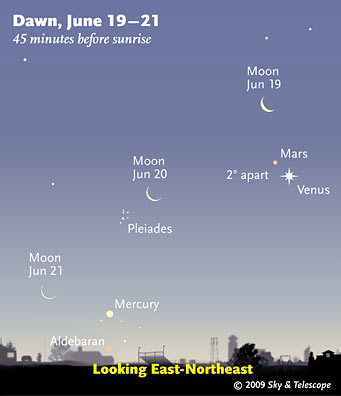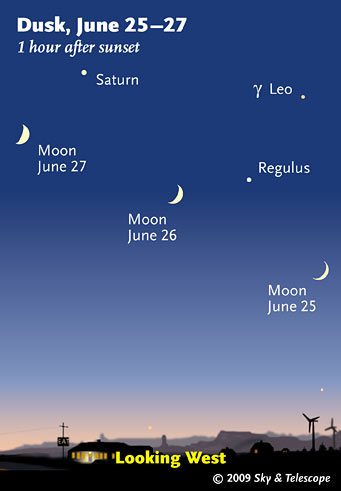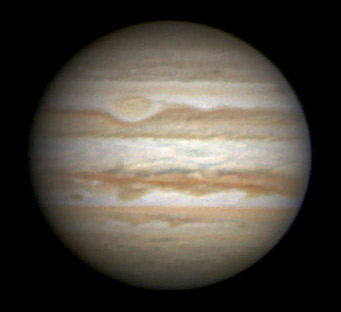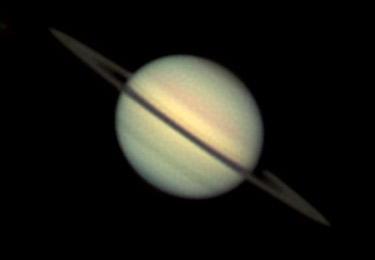Some daily events in the changing sky for June 19 – 27.

Look early in the dawn to catch Venus and Mars at their closest.
Sky & Telescope diagram
Friday, June 19
Saturday, June 20
Mercury in turn is just 0.2° from Epsilon Tauri, magnitude +3.5, in the Hyades. Can you see this star? It marks the upper tip of the "V" shape of the Hyades emerging from the sunrise for the year. First-magnitude Aldebaran 3° below them marks the V's southern tip. See the illustration above.
Rouse the other members of the party to take a look. Welcome to summer.
Sunday, June 21
Monday, June 22
Tuesday, June 23
Wednesday, June 24
It wasn't always so. Prior to July 2000, Delta Scorpii was slightly fainter than Beta above it. Delta's major flareup lasted five years, then the star faded partway down again (see light curve at the AAVSO). To me it looks suspiciously bright again. See our previous article with labeled photo.

Back in the evening sky, the waxing crescent Moon again passes Regulus and Saturn on successive days. (These scenes are drawn for the middle of North America. European observers: move each Moon symbol a quarter of the way toward the one for the previous date.)
Sky & Telescope diagram
Thursday, June 25
Friday, June 26
Saturday, June 27
Want to become a better amateur astronomer? Learn your way around the constellations. They're the key to locating everything fainter and deeper to hunt with binoculars or a telescope. For an easy-to-use constellation guide covering the whole evening sky, use the big monthly map in each issue of Sky & Telescope, the essential magazine of astronomy. Or download our free Getting Started in Astronomy booklet (which only has bimonthly maps).

The Pocket Sky Atlas plots 30,796 stars to magnitude 7.6 — which may sound like a lot, but that's less than one star in an entire telescopic field of view, on average. By comparison, Sky Atlas 2000.0 plots 81,312 stars to magnitude 8.5, typically one or two stars per telescopic field. Both atlases include many hundreds of deep-sky targets — galaxies, star clusters, and nebulae — to hunt among the stars.
Sky & Telescope
Once you get a telescope, to put it to good use you'll need a detailed, large-scale sky atlas (set of charts; the standards are Sky Atlas 2000.0 or the smaller Pocket Sky Atlas) and good deep-sky guidebooks (such as Sky Atlas 2000.0 Companion by Strong and Sinnott, the more detailed and descriptive Night Sky Observer's Guide by Kepple and Sanner, or the classic Burnham's Celestial Handbook). Read how to use them effectively.
Can a computerized telescope take their place? I don't think so — not for beginners, anyway, and especially not on mounts that are less than top-quality mechanically. As Terence Dickinson and Alan Dyer say in their Backyard Astronomer's Guide, "A full appreciation of the universe cannot come without developing the skills to find things in the sky and understanding how the sky works. This knowledge comes only by spending time under the stars with star maps in hand and a curious mind." Without these, "the sky never becomes a friendly place."
More beginners' tips: "How to Start Right in Astronomy".
This Week's Planet Roundup
During the second half of June, six of the seven planets (not counting Earth) are positioned at dawn within a 100° span of sky, from low in the east to fairly high in the south. From left to right they're Mercury, the Venus-Mars pair, Uranus, and the Jupiter-Neptune pair.
This comes 25 years after very the rare gathering of all seven planets — and then-planet Pluto — into a span of only 60° in January 1984.

Jupiter's Great Red Spot (GRS) is pale this year, and the South Equatorial Belt, which the Red Spot sits in, looks pretty quiet. But the North Equatorial Belt (NEB, below center) is going nuts! In the parts of the NEB north of the Great Red Spot, the prominent white swirls of three weeks ago have morphed into dark chaos. Also note the very long, straight, diagonal red-brown line crossing the NEB.
Christopher Go took this image at 17:54 UT June 17, 2009, when the central-meridian longitude (System II) was 150°. South is up.
For all of the Red Spot's central-meridian crossing times, good worldwide, use our Red Spot calculator or print out our list for 2009.
Mercury (about magnitude 0) is having a poor apparition deep in the glow of dawn. Look for it in morning twilight about 25° lower left of Venus and Mars. Binoculars will help.
Venus and Mars (magnitudes –4.3 and +1.1, respectively) remain together due east during dawn. Venus is a dazzler; Mars is 150 times fainter. They're only 2° or 3° apart this week, hardly more than a finger's width at arm's length. June 22nd is their conjunction date, when they're separated by 2.0°. Look for Mars to Venus's upper left early in the week, and directly above Venus later.
Four reasons combine to create their great disparity in brightness. Mars is farther from the Sun so it's illuminated less brightly than Venus, Mars is a smaller planet, its surface is darker and less reflective than Venus's white clouds, and Mars is currently farther from Earth.
Jupiter (magnitude –2.6, in Capricornus) now rises before midnight and shines brightly in the south by dawn. The sharpest telescopic glimpses may come during morning twilight, when the atmospheric seeing sometimes turns very steady.

On June 16th Saturn's rings were still tipped 3.7° to our line of sight, but they were tipped a mere 0.8° to the incoming sunlight. All year the rings' tilt to the Sun has been steadily decreasing, and accordingly, the rings have been getting darker and darker. Keep watch! Saturn is becoming harder to observe as it moves lower in the west each evening.
S&T's Sean Walker took this stacked-video image using a 14-inch Schmidt-Cassegrain scope at f/22, a DMK21AU04.AS camera, and Custom Scientific RGB filters.
S&T: Sean Walker
Saturn (magnitude +1.0, in Leo) is still fairly high in the west at dusk, but it sinks lower as the evening advances. In a telescope Saturn's rings are narrowing again, appearing only about 3.5° from edge on. And see how they've dimmed! The caption at right tells why.
Uranus (magnitude 5.8, in Pisces) is between Venus and Jupiter before dawn.
Neptune (magnitude 7.9, in Capricornus) remains only 3/4° from Jupiter, but it's 16,000 times fainter. See our finder charts for Uranus and Neptune.
Pluto (14th magnitude, in northwestern Sagittarius) is highest in the south around midnight or 1 a.m. See the finder chart in the June Sky & Telescope, page 53.
All descriptions that relate to your horizon or zenith — including the words up, down, right, and left — are written for the world's mid-northern latitudes. Descriptions that also depend on longitude (mainly Moon positions) are for North America. Eastern Daylight Time (EDT) equals Universal Time (also known as UT, UTC, or GMT) minus 4 hours.
To be sure to get the current Sky at a Glance, bookmark this URL:
http://SkyandTelescope.com/observing/ataglance?1=1
If pictures fail to load, refresh the page. If they still fail to load, change the 1 at the end of the URL to any other character and try again.
 0
0
Comments
You must be logged in to post a comment.